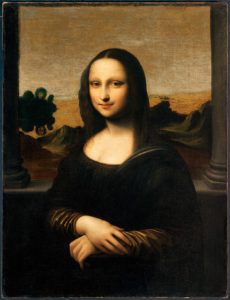The Mona Lisa is one of the world’s most iconic and enigmatic paintings. Art historians and amateur detectives have combed over the work, looking for answers to everything, from da Vinci’s technique to the possible real location of the fantasy backdrop to the sitter’s identity (which has since been confirmed). It’s been the property of the French state for centuries, so the possibility of it being offered on the market is practically zero. But who knows its value now that a second Mona Lisa might be out and about?
The painting that some specialists call the Isleworth Mona Lisa has divided experts for a little over a century. The painting was reportedly brought from Italy to Britain in the 1780s. In 1913, the English art collector Hugh Blaker purchased the work, becoming the first prominent figure in the art world to promote the painting as a genuine Leonardo. Blaker kept the portrait in his studio in the West London neighborhood of Isleworth, where the painting gained its nickname. The one organization that seems to assert its authenticity is the Mona Lisa Foundation, a nonprofit founded in Zürich in 2011 to study the Isleworth Mona Lisa to see if it qualifies as a genuine painting by Leonardo da Vinci. However, the Mona Lisa Foundation was founded by the painting’s current owners and openly acts on their behalf. To say that they might be slightly biased in favor of the Isleworth Mona Lisa being an original Leonardo would not be a difficult conclusion. The group claims it is the first of two versions of the portrait, the second being the version we all know and love hanging in the Louvre. The portrait’s subject, Lisa del Giocondo, appears slightly younger, with a slimmer face, hence why some specialists believe that the work precedes the Mona Lisa. According to the Foundation, “We have proven beyond reasonable doubt that Leonardo painted two Mona Lisas and this is the only candidate to be the second.” I’m not entirely sure how I feel about art historians using the language of lawyers in a statement of attribution. Speaking with that level of certainty regarding something so old can often be a little suspicious.
Some prominent art historians, however, are unconvinced by the data, with many claiming that the work is likely nothing more than a copy of Leonardo‘s original. Some have noted that the Isleworth Mona Lisa is a painting on canvas, while practically every painting by Leonardo da Vinci, including the Mona Lisa, is on panel. Furthermore, while the painting attempts to blend colors and create a softness using Leonardo’s sfumato technique, some da Vinci experts claim that the work does not contain sfumato to the extent that Leonardo would have used it. Martin Kemp, professor emeritus of art history at Oxford, stated that claims of long-lost masterworks are often typical for those attempting to increase the value of a painting with contested authorship. When asked who he thought created the work, Kemp said it can be difficult to successfully identify a creator, especially when the creator is trying to copy another artist’s technique.
Though I’m not entirely sure where I fall on the issue, I must admit that Kemp makes an incredibly valid point. It isn’t easy to attribute a work to a specific artist when the goal of the work is to try to copy the style and technique of another. Much of the evidence favoring a positive Leonardo attribution comes from style, brushstroke patterns, and composition. So I think we can find a lot of similarities between the debate surrounding the Isleworth Mona Lisa’s authenticity and that of the de Brécy Tondo, a Madonna & Child sometimes attributed to Raphael. Some will highlight the similarities between the de Brécy Tondo and Raphael’s Sistine Madonna as evidence that the same Renaissance master created both paintings, as opposed to the skeptics who claim the Tondo is just a later copy. People will bring up everything from brushstroke patterns to facial recognition software to make their point. However, so much of that can be dismissed simply by pointing out that it wouldn’t be much of a copy if it didn’t look almost the same as the original. It would be incredible to have a second version of the Mona Lisa out there in the world, but sometimes you can’t know for sure. It could be a Leonardo or a copy by one of his students or followers. The whole point of making a copy is that the author tries to match the original.
But of course, much of the coverage surrounding the Isleworth Mona Lisa consists of how much it might be worth. Given it is in private hands, the current owner may sell it if they choose. Some publications have even compared it to Salvator Mundi, the world‘s most valuable painting ever sold at auction, whose attribution to Leonardo has also been contested. The Isleworth Mona Lisa is currently being exhibited at the Promotrice delle Belle Arti Gallery in Turin until May 26, 2024.

